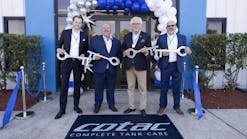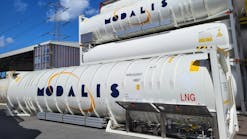CSB safety resources address hazards of cutting, welding near storage tanks
The US Chemical Safety Board (CSB) recently called attention to the hot work safety resources available free of charge through the agency’s website at www.csb.gov. The Board previously released safety videos, a safety bulletin, and accident investigations all warning of the hazards of welding, cutting, grinding, and other hot work activities in and around storage tanks containing flammable materials.
Of particular interest is the CSB’s safety video entitled “Dangers of Hot Work,” which presents key lessons from the CSB’s hot work safety bulletin, released on March 4, 2010, in Wausau WI, near the Packaging Corporation of America (PCA) facility where three workers were killed in July 2008 during a hot-work-related explosion.
CSB Chairperson Rafael Moure-Eraso said, “The CSB has examined multiple deadly hot work accidents. Our call to industry is to follow effective hazard analysis and combustible gas monitoring procedures when welding and cutting in and around storage tanks. These simple steps will save many lives.”
Hot work is defined as burning, welding, or similar spark-producing operations that can ignite fires or explosions. The CSB has conducted numerous investigations into fatal hot work accidents, with final reports which are available at the following links:
- E I DuPont De Nemours Co Fatal Hot Work Explosion
- Partridge Raleigh Oilfield Explosion and Fire
- Bethune Point Wastewater Plant Explosion
- Motiva Enterprises Sulfuric Acid Tank Explosion
The CSB’s “Dangers of Hot work” safety video uses 3-D computer animations to depict three of the hot work accidents summarized in the bulletin--Partridge-Raleigh, an oil production site in Central Mississippi; the Bethune Waste Water Treatment Plant in Daytona Beach FL; and the Motiva Enterprises Refinery in Delaware City DE.
Hot work accidents occur throughout many industries in the United States, including food processing, pulp and paper manufacturing, oil production, fuel storage, and waste treatment.
CSB Investigations Supervisor Donald Holmstrom states in the video, “We typically hear about hot work accidents weekly. It has become one of the most significant types of incidents the CSB investigates, in terms of deaths, in terms of frequency.”
The CSB began investigating hot work hazards following a July 17, 2001, explosion at the Motiva Enterprises refinery in Delaware City DE. A work crew had been repairing a catwalk above a sulfuric acid storage tank farm when a spark from their hot work ignited flammable vapors in one of the tanks. Following the July 29, 2008, accident at the Packaging Corporation of America (PCA) in Tomahawk WI--which killed three maintenance workers and injured another--the CSB began systematically tracking hotwork incidents. The CSB determined the 2008 explosion resulted from welding above an 80-foot-tall storage tank that contained highly flammable hydrogen gas--the product of bacterial decomposition of organic fiber waste inside the tank.
In the 10 months following the explosion at Packaging Corporation, the CSB deployed investigators to five other sites where hot work ignited flammable gas or vapor, including an explosion at MAR Oil in La Rue OH that killed two contractors in October 2008; an explosion that killed one and injured another at EMC Used Oil in Miami FL in December 2008; an explosion that killed a contract welder at ConAgra Foods in Boardman OR in February 2009; an explosion at A V Thomas Produce in Atwater CA in March 2009 that severely burned two employees; and the explosion of a massive gasoline storage tank that killed three workers at a TEPPCO Partners fuel distribution facility in Garner AR in May 2009.
In November of 2011 two contractors at the E I DuPont De Nemours Co located in Buffalo NY were performing welding atop a 10,000 gallon slurry tank when hot sparks ignited flammable vapors inside the tank, causing an explosion that killed one contractor and seriously injured another. The CSB’s final report and safety video entitled “Hot Work: Hidden Hazards” were released at an April 19, 2012, public meeting. The CSB said a primary cause of the blast was the failure of the company to require that the interior of storage tanks--on which hot work is to be performed--be monitored for flammable vapor. A proposed recommendation urges DuPont to require monitoring the inside of storage tanks--and the area around tanks--before performing any hot work, which is defined as welding, cutting, grinding, or other spark-producing activities.
Recently, there was a deadly accident in Moss Point MS. According to media report one man was killed and three others injured while performing welding working on a tank that was supposed to be empty. The CSB is following up on this incident and is in the process of gathering additional information.
The CSB’s 2010 Safety Bulletin provides summaries of all the hot work incidents examined by the CSB and identifies seven key lessons aimed at preventing worker deaths during hot work in and around storage tanks containing flammable materials which include:
1. Use Alternatives--Whenever possible, avoid hot work and consider alternative methods.
2. Analyze the Hazards--Prior to the initiation of hot work, perform a hazard assessment that identifies the scope of the work, potential hazards, and methods of hazard control.
3. Monitor the Atmosphere--Conduct effective gas monitoring in the work area using a properly calibrated combustible gas detector prior to and during hot work activities, even in areas where a flammable atmosphere is not anticipated.
4. Test the Area--In work areas where flammable liquids and gases are stored or handled, drain and/or purge all equipment and piping before hot work is conducted. When welding on or in the vicinity of storage tanks and other containers, properly test and--if necessary--continuously monitor all surrounding tanks or adjacent spaces (not just the tank or container being worked on) for the presence of flammables and eliminate potential sources of flammables.
5. Use Written Permits--Ensure that qualified personnel familiar with the specific site hazards review and authorize all hot work and issue permits specifically identifying the work to be conducted and the required precautions.
6. Train Thoroughly--Train personnel on hot work policies/procedures, proper use and calibration of combustible gas detectors, safety equipment, and job specific hazards and controls in a language understood by the workforce.
7. Supervise Contractors--Provide safety supervision for outside contractors conducting hot work. Inform contractors about site-specific hazards including the presence of flammable materials.
CSB videos, investigations reports, and safety bulletins are available at www.csb.gov.










